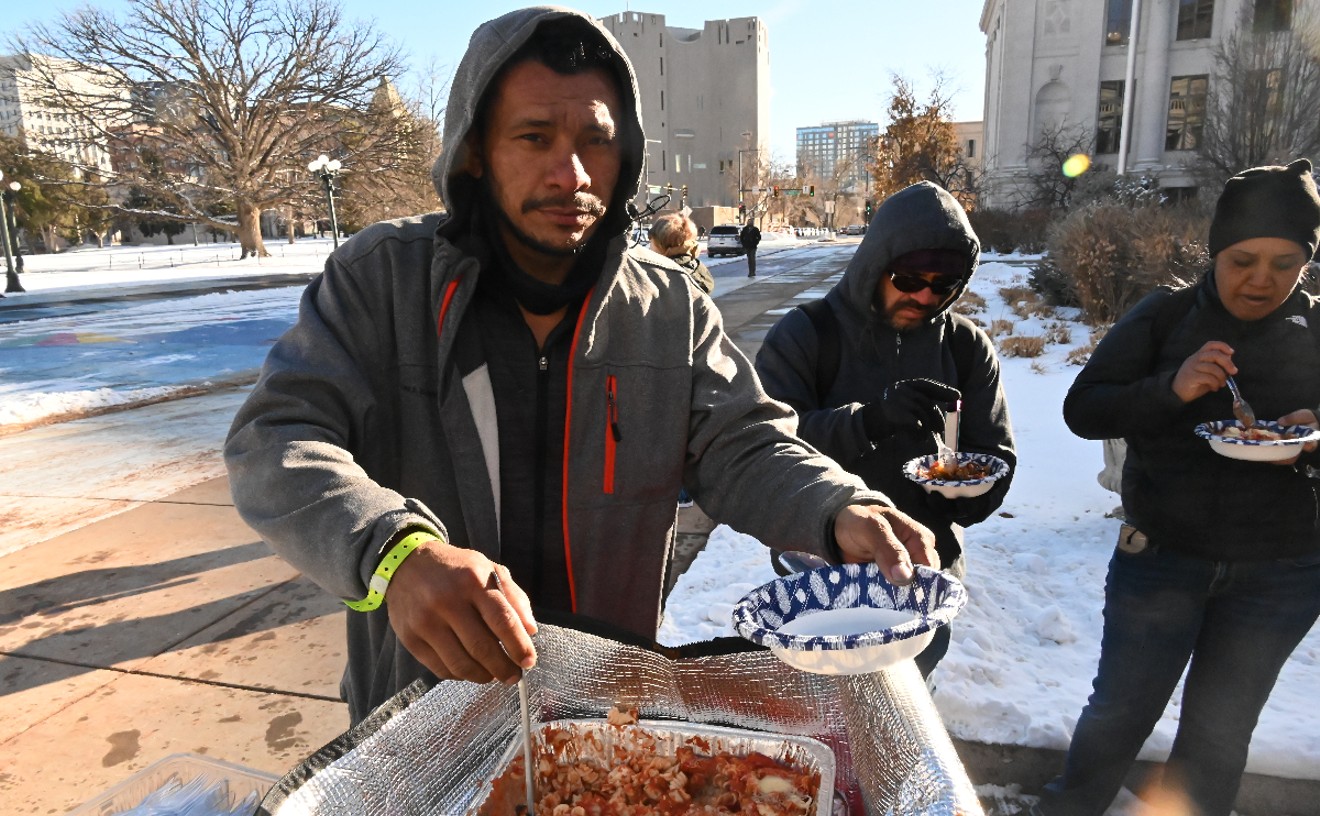At 10 p.m. on September 6, Guyton's Fun Junction, the largest amusement park between Denver and Salt Lake City, will shut down after more than forty years, bringing to a close yet another chapter in the life and death of small-town Colorado.
Although it's in the Western Slope community of Grand Junction, Fun Junction has achieved popularity far beyond the city limits. "People from all over this part of Colorado have been coming for years -- even from way down south," notes Bob Guyton, who's run the park with the help of his wife, Maebeth, since its humble beginnings in 1954.
"We get a lot of people from Moab and way over into Utah, too. And a lot of people who visit their relatives in Grand Junction from Denver say, 'We don't ride in Denver because we don't like the long lines they have there. We just wait until we come here.'"
Of course, the jolts at Fun Junction are of a relatively mild sort: There are no gravity-defying, vertebrae-torturing, chiropractor-friendly doohickeys of the sort that have bloomed of late at Six Flags Elitch Gardens. But the Ferris wheel moves at a surprisingly speedy clip, giving some patrons the impression that they're about to be flung into the middle of North Avenue, Grand Junction's main drag; the Rotor, which pins people against the wall of a cylindrical structure via centrifugal force, is dizzying in the extreme; and the Rock-O-Plane, a mini-wheel in which ticket-buyers are placed in oval cages that frequently flip upside-down, has left plenty of thrill-seekers feeling a sensation somewhere between excitement and nausea.
For the most part, though, Fun Junction exudes an aura of bucolic Americana. The six-acre grounds, accessible to anyone who can afford the cover price of 50 cents, include a quaint miniature golf course, winding paths lined by over a hundred planters overflowing with fresh blooms or assorted greenery, and horn-shaped loudspeakers that play a steady stream of tunes from yesteryear -- Scott Joplin ragtime, Dave Brubeck-style cool jazz, and so on. "There's a lot of music our employees would like to hear that we won't play," Bob concedes. "But they like this better than when we used to play carousel music. They got tired of that really fast."
There is also the drinking fountain that is set in a cartoon lion's mouth (it hasn't worked for years, but no one minds), an arcade dominated by ancient Skee-Ball games, and a Tilt-A-Whirl decorated with a sign that reads: "Celebrity Ride -- This Very Tilt-A-Whirl Appeared in State Fair, Starring Ann-Margaret, Pat Boone, Tom Ewell and Alice Faye."
Such attractions may seem tame compared to video games and laser tag, but they haven't entirely lost their charm. Bob says business has been strong until this year, when the sale of the roller coaster to a Six Flags park in Oklahoma City convinced many potential customers that Fun Junction had already thrown in the towel. The reasons the Guytons are moving on have more to do with personal matters than financial ones. Bob will be 75 next month, and Maebeth is in the same age range, yet they work fourteen-hour days throughout the season. And because they actually live in a house on the park site during the summer, it's hard to put off their chores.
"Whenever you look out the window, you see something else that needs done," Bob says.
"It feels like you're living in the middle of a zoo sometimes -- and we've been doing it for over forty years," Maebeth agrees, laughing. She adds, "I never thought I'd marry an amusement park."
In fact, Maebeth originally planned to be an opera singer, not the person handing tiny putters to four-year-olds. She majored in voice at the University of New Mexico and did graduate work at Juilliard and the University of Denver. But while she was able to use her gifts at Mesa State College in Grand Junction, where she taught music and assisted in theatrical productions until her retirement in 1989, she's been in the fun business since 1954, when Bob opened a miniature golf course dubbed the Sands (named after the red dirt that covered each hole) a few blocks from its current space, where it was relocated two years later.
Then, in 1962, the Guytons bought a series of kiddie attractions run in nearby Lincoln Park by members of the Grand Junction Lion's Club since shortly after World War II. As the decade was winding down, the couple moved the whole kit and caboodle to the Fun Junction address, and in the early to mid-Seventies, they began adding rides for bigger kids, including the Tilt-A-Whirl, which had been sitting on the state fairgrounds in Dallas. "I spent the whole winter repairing it," Bob remembers.
The times were good for the park and for Grand Junction. The city was growing rapidly due to the presence of oil shale in the area, precipitating the arrival of numerous national chains: When an Arby's was built on North Avenue, it attracted long lines of locals for months. But Fun Junction remained the place to be for everyone from toddlers to adolescents, who loved its proximity to the Chief Drive-In, where R-rated fare could sometimes be seen from the park. (In 1977, when the Chief's bill was topped by Chatterbox, a movie about a young woman with a talking vagina, the links were absolutely packed.)
After the oil-shale boom went bust in the Eighties, the Chief and its sister drive-in, the Rocket, went the way of all flesh, but Fun Junction survived -- and so, too, did Grand Junction. Thanks to a successful campaign that positioned the region as a great place for retirees, Mesa County topped the 100,000 population figure in the early Nineties, and businesses such as Home Depot, Circuit City and PetSmart rushed in. Before long, Grand Junction looked like Everytown, U.S.A., with Fun Junction among the last of the independent, homegrown outfits still in existence.
In 1994, when an exhausted Bob and Maebeth decided that they'd had enough, they tried to keep it that way by offering to sell the park to the City of Grand Junction. But officials weren't interested. According to Reford Theobold, who was Grand Junction's mayor at the time and remains a member of its city council, "It didn't even get to the formal discussion stage. We just felt that it wasn't something appropriate for the city to get into."
Next the Guytons tried to pitch the operation to someone who wanted to continue running it. This scheme went nowhere as well. "What it boils down to is that the park business requires a lot of land, and it doesn't generate as much money per square foot as a lot of other businesses might," Bob explains. "It was a labor of love for us, but there aren't that many other people with that kind of love."
As a result, Bob and Maebeth decided to peddle the rides in piecemeal fashion: The Yo-Yo is now in San Francisco, the Rotor is headed to Ohio, and the Scrambler, one of the park's wilder items, can be yours for $40,000. The land, meanwhile, will be offered to the highest bidder.
Tim Whitney, division manager for the commercial department of Grand Junction's Coldwell Banker, which is overseeing the sale, has put a price tag of $1 million on the parcel, and expects offers to start rolling in soon. "It's a really good spot," he points out. "It's right across the street from the Wal-Mart."
There's no guarantee that developers will feel the same way: The Chief Drive-In land is still vacant more than ten years after the last backseat makeout session was staged there. If no one buys his property, Bob figures he'll open up the miniature golf course again next year, sans rides -- but he admits it won't be the same. "At one time, we had a capacity that was about right for a city of 300,000. You won't find a place like this anywhere in a town the size of Grand Junction, and you never will again."
That's okay by Maebeth: Even though she raised three kids at the park and has a pair of grandchildren working there now, she knows the time is right to turn the page. But she still regrets that she and Bob couldn't find a way to keep the fun at Fun Junction rolling. "It's very fatiguing to run this place, to say the least," she says. "But I'll miss the people -- especially the children. The powers that be won't realize what they're losing until it's gone."











